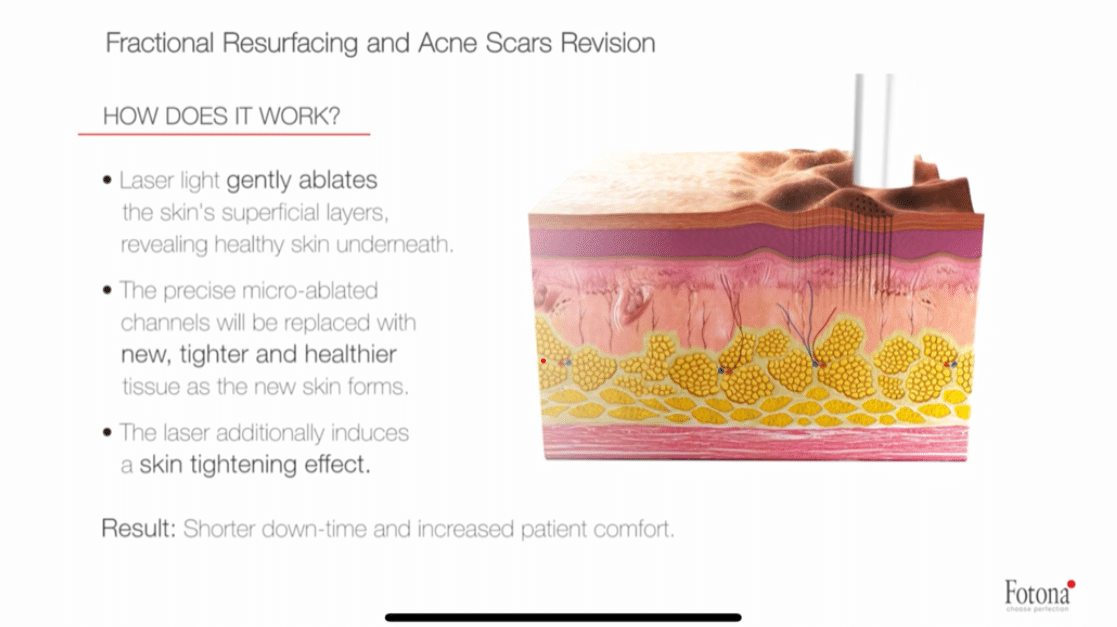TimeWalker® is a state-of-the-art aesthetic laser tool that applies Er:YAG and Nd:YAG technologies, custom-built for skincare and facial rejuvenation treatments. Leveraging a specialized fusion of Fotona’s sophisticated laser capabilities and proprietary ASP-powered operational modes, TimeWalker® excels in facilitating non-invasive facelifting procedures like Fotona4D®, SmoothEye®, and LipLase™.


The exclusive Fotona SMOOTH® technology employs Er:YAG laser pulses, triggering a unique, non-ablative thermal stimulation that initiates a dual-tissue regeneration process. This process ensures safe, regulated collagen tightening and the formation of new collagen within the tissue. The treatment outcome is immediate skin tightness and a rejuvenated appearance, and it has a prolonged effect, making it an excellent choice for upkeep treatments.
TimeWalker® also offers a range of features from cold, minimally ablative to hot, deep ablative peels and from full-field to fractional resurfacing. These functionalities allow for treatments to be customized to cater to individual skin conditions for optimal results.
TimeWalker® includes an Nd:YAG laser, ideally supplementing the ablative properties of the Er:YAG laser, with its capacity to reach deep within the skin, generating thermal effects without causing harm to the skin surface.
The groundbreaking PIANO® mode incorporated in the TimeWalker® offers full-thickness bulk heating, ensuring a safe and regulated tightening of both the dermis and epidermis while protecting the skin from excessive thermal damage.
Furthermore, Fotona’s innovative FRAC3® technology induces a three-dimensional fractional pattern in the epidermis and dermis. This technology selectively targets specific tissue chromophores, treating deeper skin imperfections associated with aging, stimulating neocollagenesis, and healing without damaging the epidermis, irrespective of the skin type.




While both Dysport and Botox are injectable treatments used to reduce the look of wrinkles and fine lines on the face, there are a few key differences between the two. Dysport is made from a different strain of botulinum toxin than Botox, and it may be more spreadable and have a quicker onset of action. However, the duration of effects and potential side effects are similar between the two treatments.
Like any medical procedure, there are potential risks and side effects associated with Botox and Dysport. Common side effects may include swelling, redness, or bruising at the site of injection, as well as headaches, nausea, and flu-like symptoms. Serious side effects, such as allergic reactions or drooping of the eyelid, are rare but possible. It is important to discuss any risks and side effects with your healthcare provider before undergoing treatment.
Yes, in addition to its use in reducing the appearance of wrinkles and fine lines, Botox can be used to treat excessive sweating (hyperhidrosis) of the underarms, hands, and feet. It works by temporarily blocking the release of a chemical that activates the sweat glands. The effects of Botox for hyperhidrosis can last for several months.
It is generally not recommended to use Botox, Dysport, or any other injectable treatment during pregnancy. While the effects of Botox and Dysport on pregnancy have not been well studied, it is important to err on the side of caution and avoid any unnecessary medical procedures during this time. If you are pregnant or planning to become pregnant, it is important to discuss your treatment options with your healthcare provider.
We also offer free consultations.